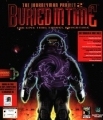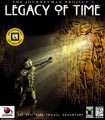Legacy of The Journeyman Project
First posted on 02 September 1999. Last updated on 31 December 2012.
Since 1992, Presto Studios has published 3 games in the Journeyman Project series. The developer has apparently made some progress on a fourth game before problems with the publisher cause its development to be suspended. All the games in the series are first person adventures that feature photorealistic graphics. You play the role of Gage Blackwood, a temporal agent who travels through time to past and future in order to safeguard mankind's history. The games are not episodic in that most of the puzzles can be solved in any order and movement is generally unrestricted. Items from one time location may be used to solve a puzzle in another. It is clear that Presto Studio has put a lot of effort into realizing the locations to where you travel throughout the series.
All the games in the series have been underrated by critics. Beginning with The Journeyman Project, each game in the series has a story that is there in its own right and not as an excuse to string a series of puzzles together. The locations you visit during your travel are far more than backdrops but are living places themselves. Equally, the end sequences in all the games in the series are worth reaching to. They all give a sense of what the adventure genre is capable of. A cinematic tour-de-force is the opening sequence of The Journeyman Project 3: Legacy of Time ,where Presto Studios uses the time travel premise to its full effect. At the start of that game, you observe the devastation of Atlantis, Eldorado, and Shangri-La. You are then put back just before the devastation to begin the game.
There have been many changes over the 3 games in the series. The game interface has been greatly simplified. The Journeyman Project 3: Legacy of Time does not require you to manipulate biochips as you must do in The Journeyman Project and The Journeyman Project 2: Buried in Time. In the first game, you have to mind the clock all the time as you have only a limited time to visit a particular location. In the second game, there are only a few timed puzzles. In the third game, there are none. As well, time travel has progressively become just part of the background. The first game is about preventing meddling with time. The second is about finding chronological anomalies. The third game simply uses time travel as a story device. As the series progresses, there is increasing interaction with the locations you visit. In the third game, you can even converse with people from their own time periods. Therefore, the problem solving element has lessened while the exploration element has increased over the evolution of the series.
Do not be mistaken; these games are certainly time travel adventures. Whether or not Atlantis truly exists is a matter that is from a long time ago. Yet, this is not time travel in its usual sense. The puzzles in this series do not involve time travel paradox in the same sense as do the puzzles in Maniac Mansion: Day of the Tentacle, where you must do an action in the past to solve a problem in the future. Here, time travel is being mainly used as a rationale for visiting different historic and future locations. This is not meant as a criticism. What is the point of the Magic School Bus? Or the Starship Enterprise? Or the stargates in Stargate SG1? Or the Tardis of Doctor Who? These are all story devices which allow the characters to visit very different worlds. I like the idea of being able to "be there", be it King Richard's castle or the fabled Atlantis. Moreover, I am grateful that the series has not chosen to dive deeper into the topic of time travel. Firstly, if the series is seriously postulating about time travel then the games are forced to deal with a lot of issues which most other time travel fictions do not even begin to address. Secondly, even if time travel exists the technology is not going to be half as interesting as the people and places in the game.
Presto Studios has obviously done a lot of historical research into King Richard's castle in The Journeyman Project 2: Buried in Time. While this effort must deserve praise, it is not the historical accuracy that matters here the most. Nor am I too concerned with how correct Buddhism in Shangri-La is portrayed in the game. What does matter is that each location to where you travel makes sense and feels like a believable world. Of course, basing a game location wholly or partly on a real life location helps. It is not the puzzles that interest me so much as the story and the place. It is the opportunity to be able to experience a story and its setting in a way only interactive fiction can deliver. There is a role for a kind of adventure games which teache history or culture, where the puzzles are questions based on what you have learned from interacting with characters or examining objects in the game. I imagine there is a good potential market here.
There are fewer puzzles in the third game than the second game in the series. It is easy to say this is part of the general problem facing today's adventure games, where gameplay takes second place to flashy graphics. This may be part of the reason. Yet I like to think that the evolution of the Journeyman Project series represents one possible future for the adventure genre. Instead of having games being puzzle-centric, the games are instead story-centric where the puzzles serve more as the way you turn the pages of a paperback novel. I like puzzles, but I believe that an adventure game is capable of being much more than a simple collection of linked puzzles.
There is a greater sense of involvement with the different locations in the third game than the previous two games in the series. Particularly striking is the ability to switch who you are using the Chameleon suit in last game and get different responses from your interaction with other characters (the Chameleon suit allows you to appear as anyone of whom you have captured an image). This twist in gameplay goes further than that of playing different characters in Broken Sword: The Shadow of the Templars or King's Quest VII: The Princeless Bride and even the token switching between characters in Indiana Jones and the Fate of Atlantis. I have always been intrigued by games where you can play different characters to solve puzzles in different ways. As an aside, I wish that action/adventure can allow you to choose between a character who can fight through the game or a character who can think way through the game.
What can the fourth game of the Journeyman Project series be like? The loose end left by the second game has provided a start for the third game. In turn, the third game has left a number of loose ends that may be starting points for a fourth game. The most obvious is the suggestion that Dr Sinclair has pinched the idea of time travel from the Sosiqui (there is even a joke storyboard on Presto Studio's site about this, but if this is going to be used for the fourth game then displaying a storyboard about it becomes an unwanted giveaway). My guess is that this loose end is simply left over from the original storyboard for the third game that is cut out as the game is put into production. Still, these kinds of questions intrigue me greatly.
It is unfortunate that The Journeyman Project 3: Legacy of Time has not received the media attention and favorable critiques that it so well deserves. It is always enticing to see a game that mixes fictional stories with historically accurate events, figures, or legends. It adds a degree of authenticity to the game that is otherwise not possible. If the production for the fourth game is ever resumed in the future, perhaps the ultimate fate of this sequel can break the curse that has clouded its predecessors.




